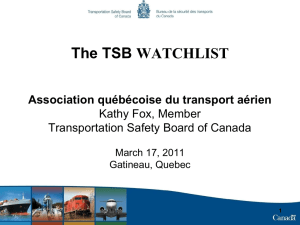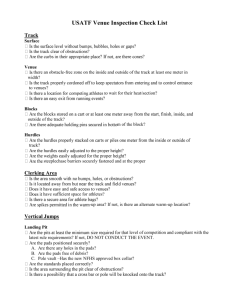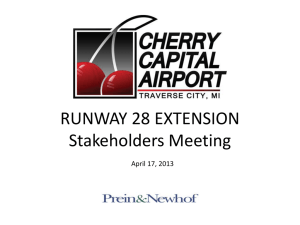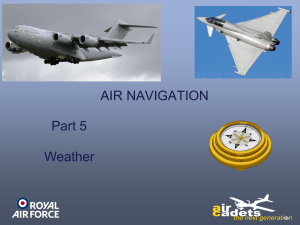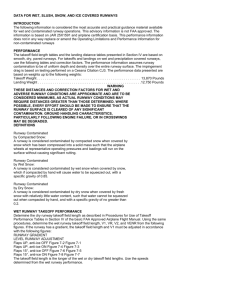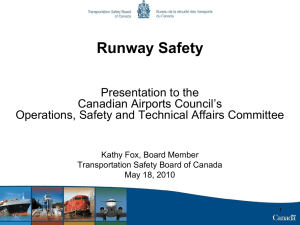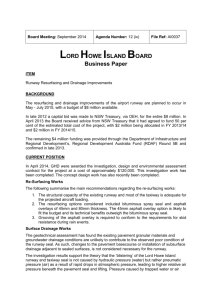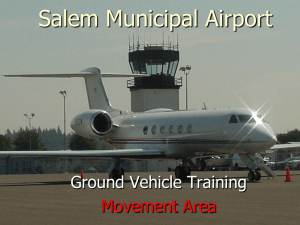View the PowerPoint presentation
advertisement
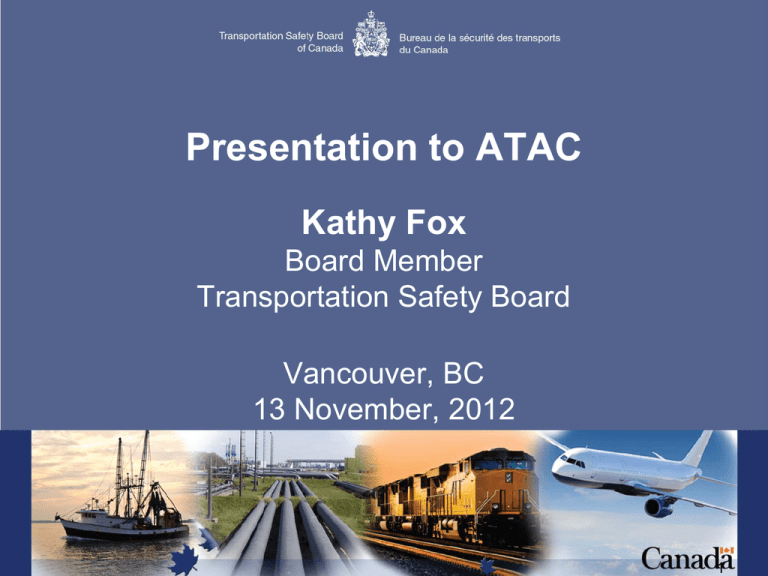
Presentation to ATAC Kathy Fox Board Member Transportation Safety Board Vancouver, BC 13 November, 2012 1 Outline • Watchlist 2012: What is it? What’s new? • Watchlist Air Issues • Related TSB Investigations • Role of Governance/Oversight • Q&A 2 Watchlist: What is it? • 9 issues of greatest risk to Canada’s transportation system • A call to action for regulators and industry • 14 of 41 recommendations “Fully Satisfactory” since 2010 • Progress on SMS and data recorders 3 Watchlist 2012 Landing Accidents and Runway Overruns Air Safety Management Systems Risk of Collisions on Runways Collisions with Land and Water Marine Safety Management Systems Loss of Life on Fishing Vessels Passenger Trains Colliding with Vehicles On-Board Video and Voice Recorders Following Signal Indications 4 Landing Accidents and Runway Overruns Runway overrun, Cargojet Boeing 727, Moncton, NB TSB Investigation report A10A0032 5 More Common Than You Might Think • • • • • • • • June 16, 2010. Embraer 145 (Ottawa) November 30, 2010. Boeing 737 (Montreal) March 12, 2011. Bombardier BD100 (Iqaluit) July 16, 2011. Boeing 727 (St. John’s) September 4, 2011. EMB-145 (Ottawa) January 9, 2012. Boeing 737 (Ft. Nelson) January 15, 2012. Pilatus PC-12/45 (Timmins) August 14, 2012. Ilyushin 76 (St. John’s) 6 Stopping Distance After an Overrun (FAA 1975-1987 study) Source: ATSB, Runway excursions, Part 2: Minimising the likelihood and consequences of runway excursions. An Australian perspective, (2009). 7 A Complex Problem • Runway length is not the only factor • Numerous lines of defence are needed to: o Prevent overruns from happening o Prevent injury or loss of life when overruns do happen 8 TSB Recommendations • Approach/landing standards: Establish clear standards limiting approaches and landings in convective weather for all air transport operators at Canadian airports. (A07-01) (Air France) (SiP) • Pilot training: Mandate training for all pilots involved in Canadian air transport operations to better enable them to make landing decisions in deteriorating weather. (A07-03) (Air France) (SI) • Procedures: Require crews to establish the margin of error between landing distance available and landing distance required before conducting an approach into deteriorating weather. (A07-05) (Air France) (SI) 9 Recommendation A07-06 The Department of Transport require all Code 4 runways to have a 300 m runway end safety area (RESA) or a means of stopping aircraft that provides an equivalent level of safety. Recommendation A07-06 TSB Investigation Report A05H0002 Current assessment: SiP 10 Risk of Collisions on Runways © Australian Transport Safety Bureau Reproduced with permission Beech 1900, following runway collision with Beech A90 King Air, Quincy Municipal Airport, IL, USA. © Scroggins Aviation, reproduced with permission 11 TSB Findings • “Both crew members … were unfamiliar with the (airport) and did not correctly perceive their position on the field.” (A07O0305) • “The co-pilot did not assist in monitoring [as] he was carrying out checks while … PIC taxied the aircraft.” (A07O0305) 12 More TSB Findings • “Believing [the runway under his] control, the … controller cleared the … vehicles onto that runway, leading to a conflict with the departing WestJet.” (A08H0002) • The aircraft and vehicle “were operating on different frequencies, [and unaware] of the other's presence on the runway” (A09W0026) 13 TSB Safety Concerns • “Two heads up” • “ASDE/RIMCAS at Pearson International” • “Direct warnings to flight crews” 14 Collisions with Land and Water Cessna 206, collision with hilltop near Shawinigan, QC 15 TAWS • 2012: CARs amended to introduce requirements for the installation of Terrain Awareness Warning Systems equipped with an “Enhanced Altitude Accuracy” function in private turbine-powered aircraft configured with six or more passenger seats and in commercial aircraft configured with six or more passenger seats. 16 Exact Air 3 nautical miles before Runway 12 17 Descent Techniques C-GPBA Step down Descent 18 Exact Air Recommendations That TC “require that the design and depiction of the non-precision approach charts incorporate the optimum path to be flown.” (A12-01) Profile view with 3° descent path and ICAO Annex 4 recommendations. 19 Exact Air Recommendations (continued) That TC “require the use of the stabilized constant descent angle approach technique in the conduct of non-precision approaches by Canadian operators.” (A12-02) 20 Exact Air – Safety Concern “The Board is concerned that, despite past efforts, recognized mitigation strategies to reduce ALAs found in the FSF recommendations, are not being implemented into commercial operations.” 21 CFITs in Canada • From 2000-2009: – 129 CFIT occurrences – 128 fatalities – 5 percent of accidents, but nearly 25 percent of fatalities • Air Taxis – 26 occurrences – 42 fatalities – 7 percent of accidents, 35 percent of fatalities 22 Approach and Landing Accidents Number of accidents Number of ALAs by Operation Type Air Taxis Commuters Airlines 23 Air SMS Aéropro, Quebec City, 2010 (A10Q0098) 24 Aéropro (A10Q0098) 25 Aéropro: Findings as to Risk • “Maintenance procedures and operating practices did not permit the determination of whether the engines could produce maximum power [in an] emergency” • “ … a lack of rigour in documenting maintenance work …” • “…not recording all defects in the aircraft … log poses a safety risk [possibly depriving crew] of information that may be critical …” 26 Aéropro: Causes and Contributing Factors • “The poor safety culture at Aéropro contributed to the acceptance of unsafe practices.” • “The significant measures taken by TC did not have the expected results to ensure compliance with the regulations, and consequently unsafe practices persisted.” 27 Who Holds Decision-Makers to Account? Board of Directors / owner Shareholders / financial backers Customers Insurance companies Regulators All of the above 28 The Role of Oversight in Safety Management Safety Regulators • Do we have realistic expectations on the extent to which regulators can influence day to day safety? • Regulatory Oversight Policy versus Regulatory Oversight Effectiveness 29 Regulatory Oversight “The gap between what is legal and what is safe already is large, and it will get bigger. … Is this regulatory approach sustainable? Is it fair to airlines that do everything right? Is it fair to an unknowing public?” -William Voss, Flight Safety Foundation 30 For Further Information … www.TSB.gc.ca Twitter.com / TSBcanada 31 32
